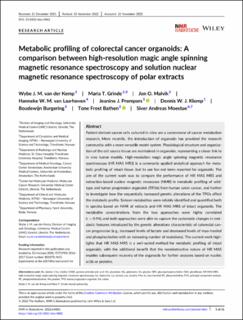| dc.contributor.author | van der Kemp, Wybe J. M. | |
| dc.contributor.author | Grinde, Maria Tunset | |
| dc.contributor.author | Malvik, Jon Olav | |
| dc.contributor.author | van Laarhoven, Hanneke W. M. | |
| dc.contributor.author | Prompers, Jeanine J. | |
| dc.contributor.author | Klomp, Dennis W. J. | |
| dc.contributor.author | Burgering, Boudewijn | |
| dc.contributor.author | Bathen, Tone Frost | |
| dc.contributor.author | Moestue, Siver Andreas | |
| dc.date.accessioned | 2023-01-12T10:26:59Z | |
| dc.date.available | 2023-01-12T10:26:59Z | |
| dc.date.created | 2022-11-21T12:56:36Z | |
| dc.date.issued | 2022 | |
| dc.identifier.citation | NMR in Biomedicine. 2022, . | en_US |
| dc.identifier.issn | 0952-3480 | |
| dc.identifier.uri | https://hdl.handle.net/11250/3042962 | |
| dc.description.abstract | Patient-derived cancer cells cultured in vitro are a cornerstone of cancer metabolism research. More recently, the introduction of organoids has provided the research community with a more versatile model system. Physiological structure and organization of the cell source tissue are maintained in organoids, representing a closer link to in vivo tumor models. High-resolution magic angle spinning magnetic resonance spectroscopy (HR MAS MRS) is a commonly applied analytical approach for metabolic profiling of intact tissue, but its use has not been reported for organoids. The aim of the current work was to compare the performance of HR MAS MRS and extraction-based nuclear magnetic resonance (NMR) in metabolic profiling of wild-type and tumor progression organoids (TPOs) from human colon cancer, and further to investigate how the sequentially increased genetic alterations of the TPOs affect the metabolic profile. Sixteen metabolites were reliably identified and quantified both in spectra based on NMR of extracts and HR MAS MRS of intact organoids. The metabolite concentrations from the two approaches were highly correlated (r = 0.94), and both approaches were able to capture the systematic changes in metabolic features introduced by the genetic alterations characteristic of colorectal cancer progression (e.g., increased levels of lactate and decreased levels of myo-inositol and phosphocholine with an increasing number of mutations). The current work highlights that HR MAS MRS is a well-suited method for metabolic profiling of intact organoids, with the additional benefit that the nondestructive nature of HR MAS enables subsequent recovery of the organoids for further analyses based on nucleic acids or proteins. | en_US |
| dc.language.iso | eng | en_US |
| dc.publisher | Wiley | en_US |
| dc.rights | Navngivelse 4.0 Internasjonal | * |
| dc.rights.uri | http://creativecommons.org/licenses/by/4.0/deed.no | * |
| dc.title | Metabolic profiling of colorectal cancer organoids: A comparison between high-resolution magic angle spinning magnetic resonance spectroscopy and solution nuclear magnetic resonance spectroscopy of polar extracts | en_US |
| dc.title.alternative | Metabolic profiling of colorectal cancer organoids: A comparison between high-resolution magic angle spinning magnetic resonance spectroscopy and solution nuclear magnetic resonance spectroscopy of polar extracts | en_US |
| dc.type | Peer reviewed | en_US |
| dc.type | Journal article | en_US |
| dc.description.version | publishedVersion | en_US |
| dc.source.pagenumber | 11 | en_US |
| dc.source.journal | NMR in Biomedicine | en_US |
| dc.identifier.doi | 10.1002/nbm.4882 | |
| dc.identifier.cristin | 2077262 | |
| dc.relation.project | EC/H2020/801075 | en_US |
| cristin.ispublished | true | |
| cristin.fulltext | original | |
| cristin.qualitycode | 1 | |

